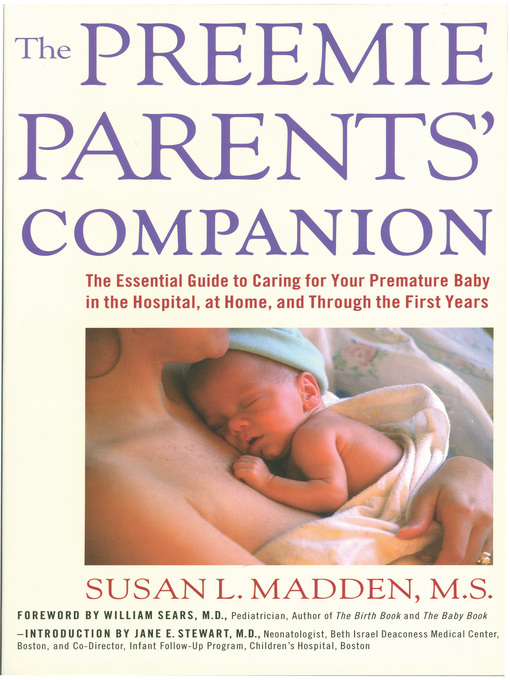How to bottle feed a baby bunny
Caring for Newborn Baby Rabbits
IF THESE ARE WILD BABIES
It’s that time of year again. Wild babies everywhere. But are they at risk?
Wild rabbits hide their nests in plain view, often in the middle of your yard, bushes, etc. If you find a nest that has been disturbed, do the best you can to restore it and leave the babies in there. If a dog discovers the nest, do your best to restore it (with grass, leaves, whatever mama has used), make sure the kits are in there, and find a way to keep the dog(s) away from the nest. Mama will return for her babies and taking them away will seriously decrease their chance of survival. If you do not see the mama—DON’T WORRY—they only nurse their babies a few minutes a day, then they stay away so as to not draw predators to the nest.
If a kit is injured or an animal brings you an injured baby, if you have no choice but to help a baby, please do not try to care or it yourself—-get it to a rabbit vet or a wildlife rehabilitator
- Local wildlife rehabilitator: https://www.
nwrawildlife.org
- List of rabbit vets: http://rabbit.org/vet-listings/
The best thing you can do for wild babies is to leave them alone (restored to the nest) or, if injured, get them to a rabbit vet or wildlife rehabilitator.
DOMESTIC/PET RABBITS
WHERE TO PUT THE BABIES
Make the babies a soft nest area in a box with clean towels. We like to put one folded towel on the bottom and another bunched on top of that, so the babies can snuggle into it. You can also purchase soft nesting wool from a pet store and put that on top of the towel. You can also take whatever nesting material they were in and put it in the box as well. Cover the box almost entirely with a light towel, making sure that there will be enough air so the babies do not suffocate. Leaving about a one inch gap at the top is usually sufficient. Keep the babies in an out-of-the way, QUIET area, such as an adult’s bedroom. If the room temperature is between 68-72 degrees you will not need to provide extra heat, but if it’s cooler than that you will need to provide extra warmth. Use a heating pad set on low and slip it under one half only of the box. We do it this way so that the babies can move to a cooler area if it gets too warm. DO NOT put babies directly on heating pad, as babies can burn themselves very badly.
Use a heating pad set on low and slip it under one half only of the box. We do it this way so that the babies can move to a cooler area if it gets too warm. DO NOT put babies directly on heating pad, as babies can burn themselves very badly.
If the babies were with their mamma, but she is not caring for them (and you are sure she is ignoring them) you may need to separate her from them so they will not get hurt. Rabbit milk is very caloric and the kittens (baby rabbits) only nurse for a few minutes a day, so if you think that she is not caring for them based only on the fact you don’t see them feed…think again. If you do think they are being neglected, you can check: Are they cold? Are they making crying sounds for more than a few minutes before (or at) feeding time? Are they blue? Is the skin shriveled? Check for dehydration: gently pinch together the skin at the nape of the neck. If it sticks together or stays in a tent, they are dehydrated.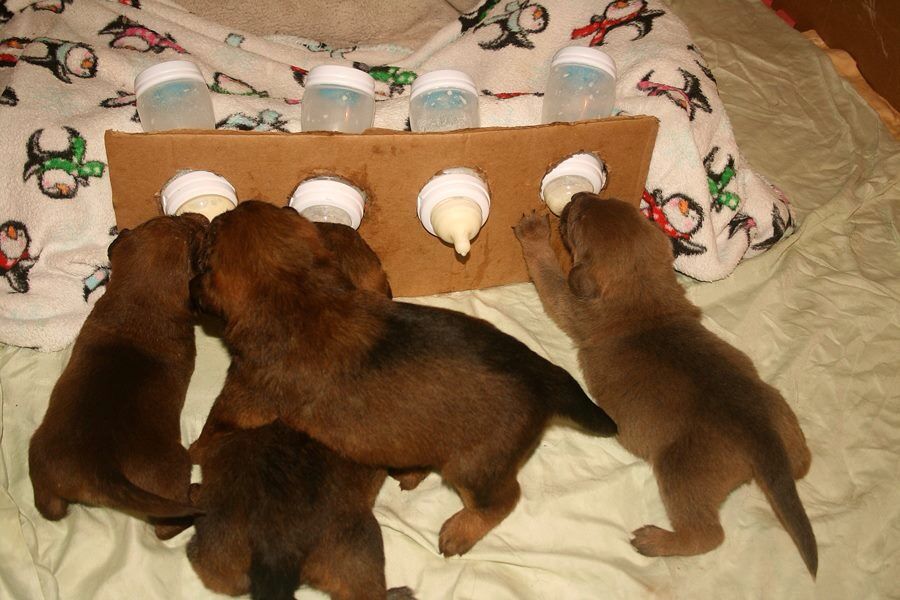 A healthy kit has a round belly, is warm, gains weight on a daily basis, and snuggles with its litter mates. If they are dehydrated, cold, losing weight or becoming injured, of course, something must be done
A healthy kit has a round belly, is warm, gains weight on a daily basis, and snuggles with its litter mates. If they are dehydrated, cold, losing weight or becoming injured, of course, something must be done
WHAT TO FEED THE BABIES
Baby rabbits should be fed Kitten Milk Replacer (KMR) or goat milk, which you can buy at pet stores, or sometimes even a local veterinarian’s office. Because rabbit milk is the most caloric of all mammals, we add in one tablespoon of 100% heavy whipping cream (no sugar) to each can of KMR. Most kits will not nurse from the baby animal bottles you can buy at stores. Instead, use a sterile oral syringe, which can be purchased at most pharmacies. A better alternative are these nipples, which come the a syringe, but you may not be able to find them locally/right away (link).
It is best to feed baby rabbits no more than twice a day, but sometimes it takes more feedings to get an adequate amount into them, especially at first.
How much to feed varies greatly on what breed of rabbit you are feeding, and how big the kit is, but here is a basic guideline for the daily amount to feed a domestic rabbit who will be approximately 5-6 pounds as an adult (average rabbit size). You can increase the amounts as needed for larger breeds.
To help the kits maintain healthy gut bacteria, go to your local health food store (and get a bottle of ACIDOPHILUS. Ask for the capsules that have the “grainy stuff” inside (they are easier to mix than the “powdery stuff”) and add a bit to the formula at each feeding.
ALL amounts below should be divided into two feedings per day.
- Newborn – 1 week
- 4-5 cc formula
- 1-2 weeks
- 10-15 cc formula
- 2-3 weeks
- 15-30 cc formula
- 3-6 weeks, until weaned
- 30 cc formula
HOW DO I DO THIS?
Baby rabbits feed from their mothers while lying on their backs. You may loosely wrap baby in a soft face cloth or hand towel and lay it on your lap or in the crook of your arm. If bunny will NOT eat this way, of course, do the best you can. It is ABSOLUTELY CRUCIAL to let the baby eat at it’s own pace—especially if it is not suckling from the syringe willingly. If you squirt the liquid in too quickly you can aspirate (get liquid in) the lungs and the rabbit will suffocate.
You may loosely wrap baby in a soft face cloth or hand towel and lay it on your lap or in the crook of your arm. If bunny will NOT eat this way, of course, do the best you can. It is ABSOLUTELY CRUCIAL to let the baby eat at it’s own pace—especially if it is not suckling from the syringe willingly. If you squirt the liquid in too quickly you can aspirate (get liquid in) the lungs and the rabbit will suffocate.
Until their eyes open (10 days): After each feeding it is important to make the bunny defecate and urinate to keep the intestinal tract and urinary system running smoothly. Use a soft cloth or a cotton ball moistened with warm water and gently stroke the genital area until the bunny starts producing stool and urine. Keep stroking until the bunny stops. You are replicating the behavior of the mother rabbit who would lick her young to stimulate them to go to the bathroom. The stool will be soft and may be varying shades of green and yellow.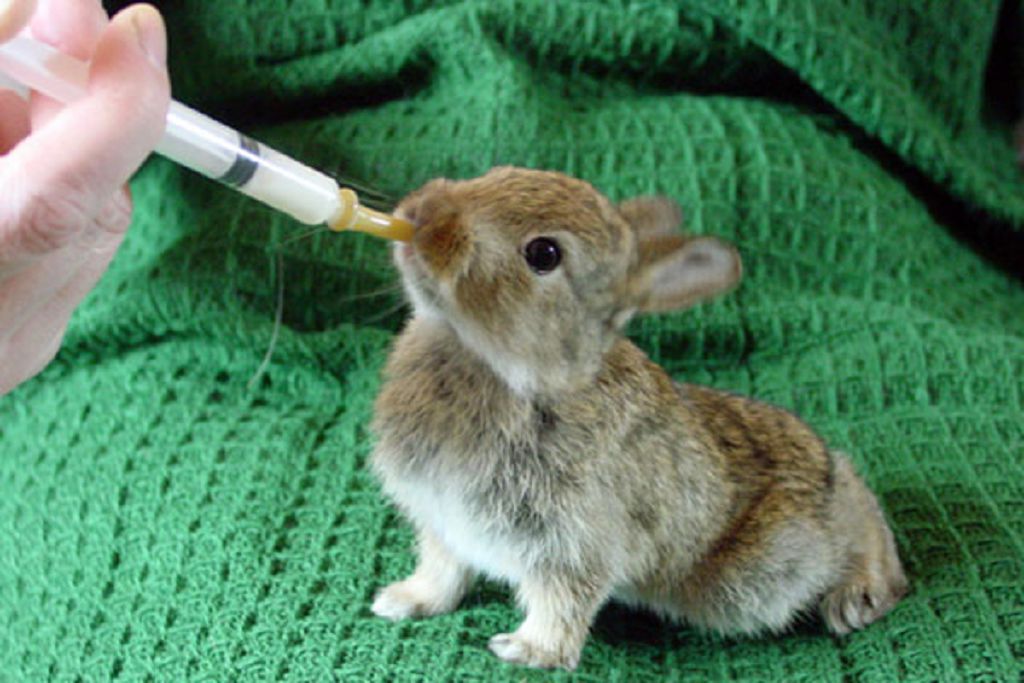 If the urine is brown and gritty, the buns are not adequately hydrated and you need to get them to a rabbit vet ASAP—-it is an emergency. Be sure to clean baby’s mouth with a damp cloth or paper towel, so that no milk dries in the hair.
If the urine is brown and gritty, the buns are not adequately hydrated and you need to get them to a rabbit vet ASAP—-it is an emergency. Be sure to clean baby’s mouth with a damp cloth or paper towel, so that no milk dries in the hair.
Baby rabbit eyes open at about 10 days of age. You may start introducing them to hay and pellets at this point, but no veggies or fruits yet. Just leave some timothy or orchard and alfalfa hay and pellets in a corner of the box where the babies can easily get to them. Make sure it the pellets are plain, high fiber and fresh, with no added goodies such as dried banana chips or seeds. Don’t ever leave a deep water dish in which a baby could drown; instead, use something shallow and rinse and fill it frequently.
If you have any questions, please contact us.
Caring For Orphan Baby Rabbits
Wild Baby Bunnies – Orphaned or Not?
Wild baby bunnies are most often not orphaned! Many people mean well when they contact HRS after discovering an “abandoned” nest of wild rabbits. Often they wish to “rehabilitate” them with some advice from others. The reality is fewer than 10% of orphaned rabbits survive a week, and the care that people attempt to provide can be illegal, unnecessary, and potentially harmful.
Often they wish to “rehabilitate” them with some advice from others. The reality is fewer than 10% of orphaned rabbits survive a week, and the care that people attempt to provide can be illegal, unnecessary, and potentially harmful.
The best thing you can do is put the bunny right back where you found him, in the general area, as the mom will only come back at night to call and find him. Leave the area. If injured, please contact a wildlife rehabber or rabbit vet immediately! You can search Google for your state/country and wildlife rehabber. Also search your state + wild rabbit rehabbers. You can call your Humane Society for referral and also check here: http://www.owra.org/find-a-wildlife-rehabilitator If you find a baby with eyes open, and he appears healthy, leave him be.
I/My Dog/My Cat Found a Rabbit Nest! What Do I Do?
Rabbits hide their nests in plain view, often putting them in the open, sometimes in the middle of the lawn, as well as in brush piles and long grass.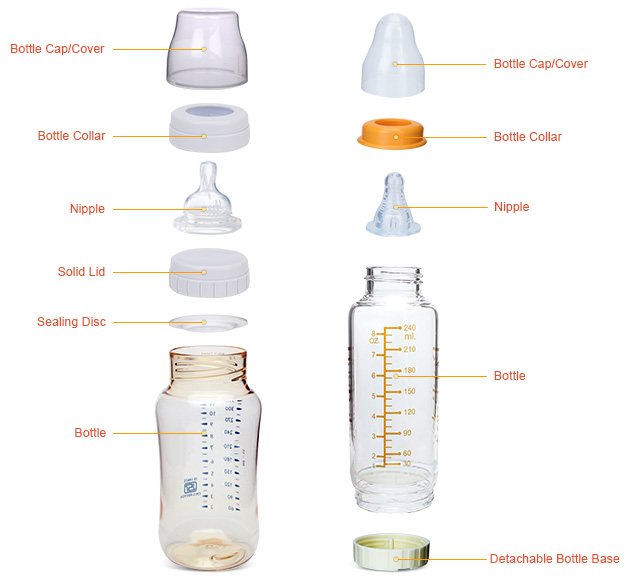 If you find a nest that has been disturbed, do all you can to restore and protect it. Do NOT bring it inside. If a dog has discovered the nest, keep your dog away from the area and reconstruct the nest with grasses. If need be, you can move the nest a few feet away where safer, even up to 5-6 feet away. A moved nest should always be covered with string in a tic tac toe pattern and monitored to be sure the mother found it and came back to the babies. She will scrabble away the surface area to feed her babies beneath her and then scrabble the earth, grass, leaves, back over the nest to hide it again so it’s pretty easy to see if the string has been disturbed and if the babies are warm.
If you find a nest that has been disturbed, do all you can to restore and protect it. Do NOT bring it inside. If a dog has discovered the nest, keep your dog away from the area and reconstruct the nest with grasses. If need be, you can move the nest a few feet away where safer, even up to 5-6 feet away. A moved nest should always be covered with string in a tic tac toe pattern and monitored to be sure the mother found it and came back to the babies. She will scrabble away the surface area to feed her babies beneath her and then scrabble the earth, grass, leaves, back over the nest to hide it again so it’s pretty easy to see if the string has been disturbed and if the babies are warm.
Baby jackrabbits wait like this for momBabies should never be put back into a nest that has been flooded with water, has bugs/ants visibly crawling in and out, or if a baby has been killed and there is blood in the nest. Use common sense. Baby bunnies who have fleas are compromised and should be immediately taken to a wildlife rehabber or humane society, rabbit vet.

Rabbit mothers nurse their babies for approximately 5 minutes a day. Both wild and domestic mothers will be in the nest early in the morning and then again in the evening. The milk is very rich and the babies “fill up” to capacity within minutes. Mother rabbits do not “sit” on the babies to keep them warm as do some mammals and birds. They build a nest with fur and grasses which helps to keep the babies warm in between feedings. For domestic/pet rabbits, do not force a mother rabbit to sit in the nest box. You can pick up the babies and see if they are feeding by checking the size of their stomachs (should not be sunken in), the pinkness of their skin and activity level (they should not be blue in color or sluggish in movement) and the amount of time that you hear them crying (baby bunnies should be quiet most of the day….if they are crying constantly then they are not getting fed). If you come across a nest of wild bunnies, and the mother is nowhere to be seen, please DO NOT disturb them.
If your dog disturbs a nest, or you find a wild bunny with his eyes open, please put him back if not injured. Mom will be coming back at night to call and feed him only once in the middle of the night. Do not take the bunny inside or feed him! IT IS A MATTER OF HIS/HER SURVIVAL AND UP TO US AS HUMANS TO LEAVE NATURE BE AND LET THE MOM CARE FOR HER YOUNG. We often hear of mothers moving their babies and their nests, and have seen moms come back every night for up to a week to look for her missing baby. Do not take the baby from the mom or she will be frantic. Many call or write saying, “… but it is raining, etc., ” but remember, these are wild bunnies and belong out there.
I/My Dog/My Cat Destroyed a Wild Rabbit Nest! What Do I Do?
Remake the nest as best you can with grasses, hay, straw in the same place. Nests can be moved to a safer place up to 10′ away from the original site and can be reconstructed if necessary. To make a new nest, dig a shallow hole about 3″ deep and put into it as much of the original material as you can recover, including the mother’s fur. Add dried grass as needed, and put the young back. Mother rabbits return to the nest to nurse only at night, staying away as much as possible so as not to attract predators. To determine if the mother is returning, create a tic-tac-toe pattern over the nest with straw, grasses or tiny twigs. Wait 24 hours to see if the twigs have been disturbed. She may be able to feed them without moving the twigs much, so double check–If the babies look healthy, are warm, then the mother is coming back. If they are cold, dehydrated, get them to a professional; do not care for them yourself. Please contact a Wildlife Rehabber or rabbit vet or Humane Society immediately. Google your state and wildlife rehabbers. Also check http://www.humanesociety.org/animals/resources/tips/find-a-wildlife-rehabilitator.html and http://www.owra.org/find-a-wildlife-rehabilitator
Add dried grass as needed, and put the young back. Mother rabbits return to the nest to nurse only at night, staying away as much as possible so as not to attract predators. To determine if the mother is returning, create a tic-tac-toe pattern over the nest with straw, grasses or tiny twigs. Wait 24 hours to see if the twigs have been disturbed. She may be able to feed them without moving the twigs much, so double check–If the babies look healthy, are warm, then the mother is coming back. If they are cold, dehydrated, get them to a professional; do not care for them yourself. Please contact a Wildlife Rehabber or rabbit vet or Humane Society immediately. Google your state and wildlife rehabbers. Also check http://www.humanesociety.org/animals/resources/tips/find-a-wildlife-rehabilitator.html and http://www.owra.org/find-a-wildlife-rehabilitator
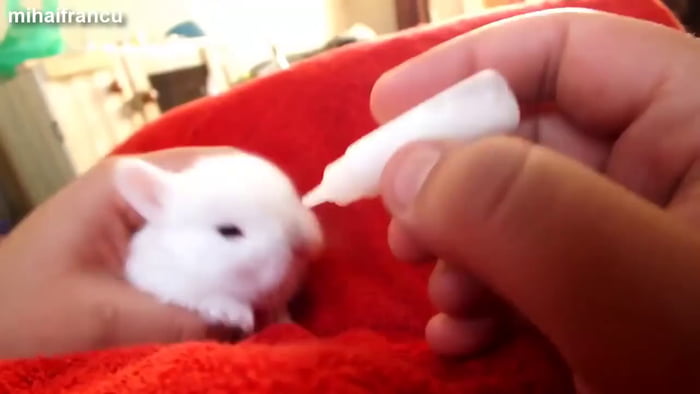
How Do I Know If the Wild Baby Bunnies Need Help?
Very young wild baby bunnies with eyes closed and ears back rarely survive in captivity, even given the most expert human care; and so it is very important to determine whether they really need help. Try to assess whether the infants seem warm and healthy or cold, thin, and dehydrated. One test for dehydration is to gently pinch the loose skin at the back of the neck. If it does not spring back in one second, or stays in a “tent,” the bunny is SEVERELY dehydrated and needs rehabilitation IMMEDIATELY by a professional rabbit vet or rehabber. Another test is to stroke the genital area to stimulate elimination if the eyes are closed. If the pee is brown and gritty, the mother rabbit has not been there to help the bunnies urinate. The brown, gritty urine is toxic, and the infant bunny must be cared for by a professional. Please contact a Wildlife Rehabber or rabbit vet immediately. Google your state and wildlife rehabber, call your Humane Society, and also check http://www.humanesociety.org/animals/resources/tips/find-a-wildlife-rehabilitator.html and http://www.owra.org/find-a-wildlife-rehabilitator.
Google your state and wildlife rehabber, call your Humane Society, and also check http://www.humanesociety.org/animals/resources/tips/find-a-wildlife-rehabilitator.html and http://www.owra.org/find-a-wildlife-rehabilitator.
Older baby bunnies who are found outside of the nest may not be orphaned or in need of assistance. This is most often the case. Baby cottontails are born without fur but develop a full coat in a week. Their eyes open in 10 days, and in three to four weeks they are weaned. At this age, they may explore the world outside of the nest but return there to sleep. They are not ignored by the mother but stay with the family group until four or five weeks of age. To determine whether a bunny of this age needs assistance, first see if the bunny feels cold to the touch; perform the dehydration test. Also look for bleeding, convulsing, fly larvae, broken limbs; if any, get to a rabbit vet or emergency vet immediately. If he is just out and about, leave him be. He is discovering his world, waiting for mom to return at night when we humans are asleep. Don’t assume because he is letting you pick him up, he needs help. They are prey animals, taught to freeze when a predator (or human) approaches. Leave him be!
He is discovering his world, waiting for mom to return at night when we humans are asleep. Don’t assume because he is letting you pick him up, he needs help. They are prey animals, taught to freeze when a predator (or human) approaches. Leave him be!
What if the Baby Bunny is Injured?
Either call or take him to your local rabbit vet, humane society or animal shelter/animal control. Call first as often they will come pick up the baby. If after hours, contact a local emergency rabbit vet or rabbit vets found here and also here. The best thing you can do for an injured wild baby bunny is to get in touch with a skilled Wildlife Rehabber by searching your state/country and wildlife rehabber, or calling your Humane Society, and or trying this link http://www.humanesociety.org/animals/resources/tips/find-a-wildlife-rehabilitator.html and http://www.owra.org/find-a-wildlife-rehabilitator
Is there anything I can do to avoid orphaning wild baby bunnies?
The harsh reality is that many of us who care about wild baby bunnies may be contributing to the suffering and death. House cats who roam outside will kill about every other time they go out. And unlike feral cats who hunt because they are hungry, and kill immediately, house cats maul and torment their prey, sometimes skinning baby bunnies alive. Cat owners need to provide managed outdoor habitats for their cats – such as window boxes or pens. Providing a bell on your cat will help warn the wildlife if you cannot keep him inside. Keep your dogs on a leash with you if you see a rabbit nest.
House cats who roam outside will kill about every other time they go out. And unlike feral cats who hunt because they are hungry, and kill immediately, house cats maul and torment their prey, sometimes skinning baby bunnies alive. Cat owners need to provide managed outdoor habitats for their cats – such as window boxes or pens. Providing a bell on your cat will help warn the wildlife if you cannot keep him inside. Keep your dogs on a leash with you if you see a rabbit nest.
Lawn chemicals can produce convulsing death in baby rabbits. According to the Poison Control Center for Animals, lawn applications that contain herbicides are not directly toxic to small animals; but they may make toxic plants more palatable to them and may make the animals sick for a few days. Products which contain insecticides, such as Dursban or Diazinion, which are added to many lawn products to control fleas or grubs in the lawn, are toxic.
The Bunny is
Wild and Really Orphaned – How do I care for it?Again, make sure you KNOW for sure the mom was killed and the bunnies are abandoned (not warm, etc.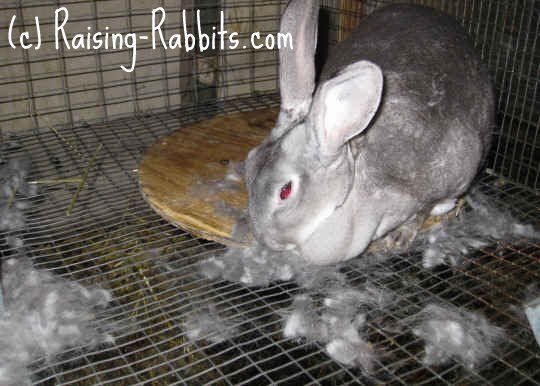 ). You will not see the mom. The mom will only come back in the middle of the night to feed her babies. If the mom was killed, the best thing you can do for a wild orphaned baby bunny is to get in touch with a skilled rehabilitator. In the meantime, call your local humane society or animal control and one of these vets for a wildlife referral: Rabbit Vets and Pet Bunny Vets. Google your state and wildlife rehabbers, and also try http://www.humanesociety.org/animals/resources/tips/find-a-wildlife-rehabilitator.html and http://www.owra.org/find-a-wildlife-rehabilitator
). You will not see the mom. The mom will only come back in the middle of the night to feed her babies. If the mom was killed, the best thing you can do for a wild orphaned baby bunny is to get in touch with a skilled rehabilitator. In the meantime, call your local humane society or animal control and one of these vets for a wildlife referral: Rabbit Vets and Pet Bunny Vets. Google your state and wildlife rehabbers, and also try http://www.humanesociety.org/animals/resources/tips/find-a-wildlife-rehabilitator.html and http://www.owra.org/find-a-wildlife-rehabilitator
How much formula should I feed a Wild Orphaned Bunny until I get him/her to a rehabber?
The following is a guideline for the daily amount to feed a TRULY orphaned wild bunny (mother was killed, etc.) Remember with wild bunnies, the mom only comes back at night to call and feed him once or so for 5 mins; please put him back for her if just found and healthy. She leaves them alone between feedings.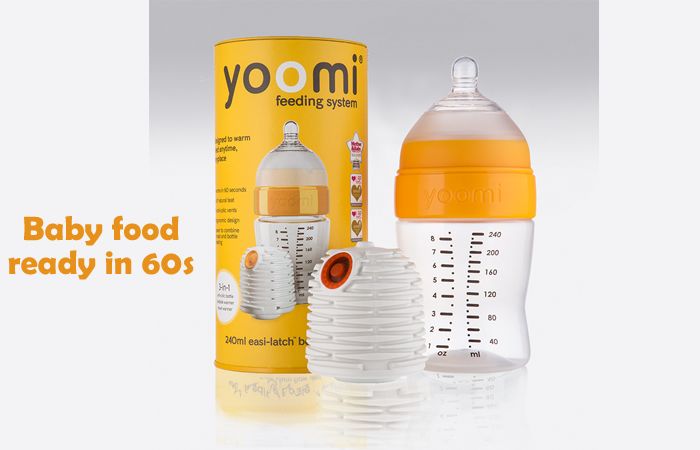 Don’t assume they are abandoned! Wild rabbits NEED a skilled wildlife rehabber. You should not feed at home or the chances of their surviving is extremely low! Most die from bloat, wrong feedings/stress. These feedings are NOT meant to take place of an actual rehabber, but for someone only who may live too far from a rehabber and is faced with a wild mother, killed, for example. All others need to call your humane society, local rabbit vet, or google your state and wildlife rehabber. You can also check here http://www.humanesociety.org/animals/resources/tips/find-a-wildlife-rehabilitator.html and http://www.owra.org/find-a-wildlife-rehabilitator
Don’t assume they are abandoned! Wild rabbits NEED a skilled wildlife rehabber. You should not feed at home or the chances of their surviving is extremely low! Most die from bloat, wrong feedings/stress. These feedings are NOT meant to take place of an actual rehabber, but for someone only who may live too far from a rehabber and is faced with a wild mother, killed, for example. All others need to call your humane society, local rabbit vet, or google your state and wildlife rehabber. You can also check here http://www.humanesociety.org/animals/resources/tips/find-a-wildlife-rehabilitator.html and http://www.owra.org/find-a-wildlife-rehabilitator
Age + Amount (This WILL vary SO MUCH depending on type of rabbit. It is impossible over the Internet to see your particular rabbit, so this is only approximate.) Use KMR kitten or KMR kitten plus Goat milk, regular not low fat. Add a pinch of acidophilus (aka Probiotic) to the formula to promote healthy gut flora.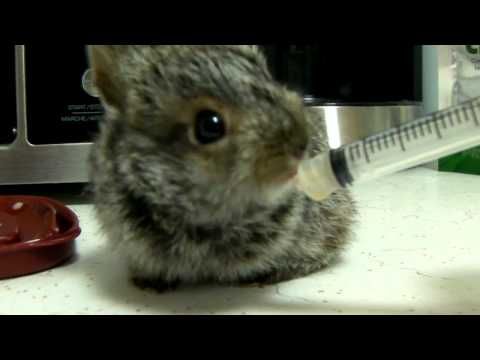 Formulas vary depending on region. Avoid Esbilac and any puppy formulas! FEED TWICE A DAY ONLY for healthy babies, three times if low weight. It may be easiest to start with a 3 cc/ml syringe or an eyedropper. Feed only with the bunny sitting UPRIGHT, and point syringe down towards bottom or side of mouth, so if too much comes out, the baby does not aspirate. At first, they may only take a few drops at one feeding until they are not stressed and used to this.
Formulas vary depending on region. Avoid Esbilac and any puppy formulas! FEED TWICE A DAY ONLY for healthy babies, three times if low weight. It may be easiest to start with a 3 cc/ml syringe or an eyedropper. Feed only with the bunny sitting UPRIGHT, and point syringe down towards bottom or side of mouth, so if too much comes out, the baby does not aspirate. At first, they may only take a few drops at one feeding until they are not stressed and used to this.
Newborn to One Week: 2- 2+1/2 cc/ml each feeding (two feedings per day).
1-2 weeks: 5-7 cc/ml each feeding (two feedings per day). (depending on bunny..may be much LESS if smaller rabbit!) Newborn babies (if eyes closed) all need to be stimulated to urinate and defecate prior to or following feeding until their eyes open. (Except Jackrabbits do not). *See how to below.
2-3 weeks: 7-13 cc/ml each feeding (two feedings). Domestic eyes open at about 10 days of age. Start introducing them to timothy and oat hay, pellets and water (always add fresh greens for wild ones).
Start introducing them to timothy and oat hay, pellets and water (always add fresh greens for wild ones).
3-6 weeks: 13-15 cc/ml each feeding (two feedings–again, may be LESS depending on size of rabbit! A cottontail/brush bunny will take so much less!! Half this at most.) Cottontails wean and release about 3-4 weeks and jackrabbits much later (9+ weeks), whereas domestic rabbits are 6 weeks.
6 weeks-9weeks for Jackrabbits only, continue up to 9 weeks with formula, gradually changing to a dish for the warm formula, replacing the formula after 9 weeks slowly, continue adding more of their natural greens and hay (dandelions, oat hay, timothy hay, Italian parsley, carrot tops, small carrots cut up) and a small water bowl. Most markets will sell these greens. They need a rehabber before release!
Wild rabbits NEED a skilled wildlife rehabber. These feedings are NOT meant to take place of an actual rehabber, but for someone who may live too far from a rehabber and is faced with a wild mother, killed, for example. Please call your humane society for referrals to rehabbers, or your rabbit vets, or google your state or country and wildlife rehabbers. You can also try here: http://www.humanesociety.org/animals/resources/tips/find-a-wildlife-rehabilitator.html and by state here: http://www.owra.org/find-a-wildlife-rehabilitator or http://www.owra.org/find-a-wildlife-rehabilitator
Please call your humane society for referrals to rehabbers, or your rabbit vets, or google your state or country and wildlife rehabbers. You can also try here: http://www.humanesociety.org/animals/resources/tips/find-a-wildlife-rehabilitator.html and by state here: http://www.owra.org/find-a-wildlife-rehabilitator or http://www.owra.org/find-a-wildlife-rehabilitator
*After each feeding it is important to gently make the bunny defecate and or urinate (brush bunnies/cottontails only..if the eyes are not opened yet) to keep the intestinal and urinary system running smoothly (just UNTIL their eyes open). No need to do this for jackrabbits; they go on their own. Use a cotton ball moistened with warm water after eating, and gently stroke the anal area until the bunny starts producing stool and urine and keep stroking until the bunny stops. You are reproducing the behavior of the mother rabbit who would lick her young to stimulate them to go to the bathroom and to keep the nest clean.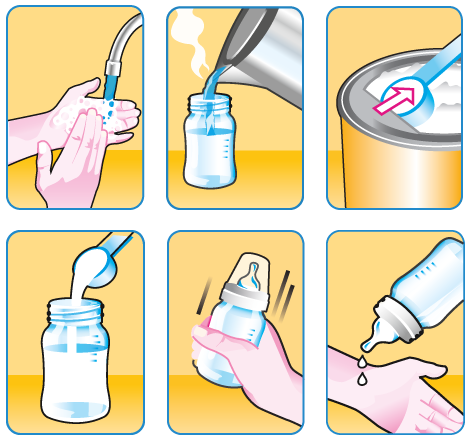 Again, ONLY if the eyes are still closed. Handle a wild rabbit only during feedings as excessive handling can be extremely stressful/potentially fatal. Wild rabbits don’t need heat if furred and healthy. Wild rabbits should not be fed at home, but get them to a professional rehabber as it IS CRITICAL for their survival and to be with their own kind. Most die from overfeeding and/or stress.
Again, ONLY if the eyes are still closed. Handle a wild rabbit only during feedings as excessive handling can be extremely stressful/potentially fatal. Wild rabbits don’t need heat if furred and healthy. Wild rabbits should not be fed at home, but get them to a professional rehabber as it IS CRITICAL for their survival and to be with their own kind. Most die from overfeeding and/or stress.
As soon as the wild bunnies’ eyes are open, you may introduce them to plain alfalfa pellets, hay, such as oat hay, timothy, alfalfa and veggies such as carrot tops, Italian parsley, dandelion greens. Dandelion greens and hay (timothy and oat hay) are extremely important for wild rabbits. You can add whole oats from a feed store, and some grated carrots. The greens must be fresh, rinsed, and replaced if not eaten in a few hours. You can place them in a cup of cold water with just the tops sticking out to keep them fresher. (For a domestic rabbit baby, see section under the Domestic heading).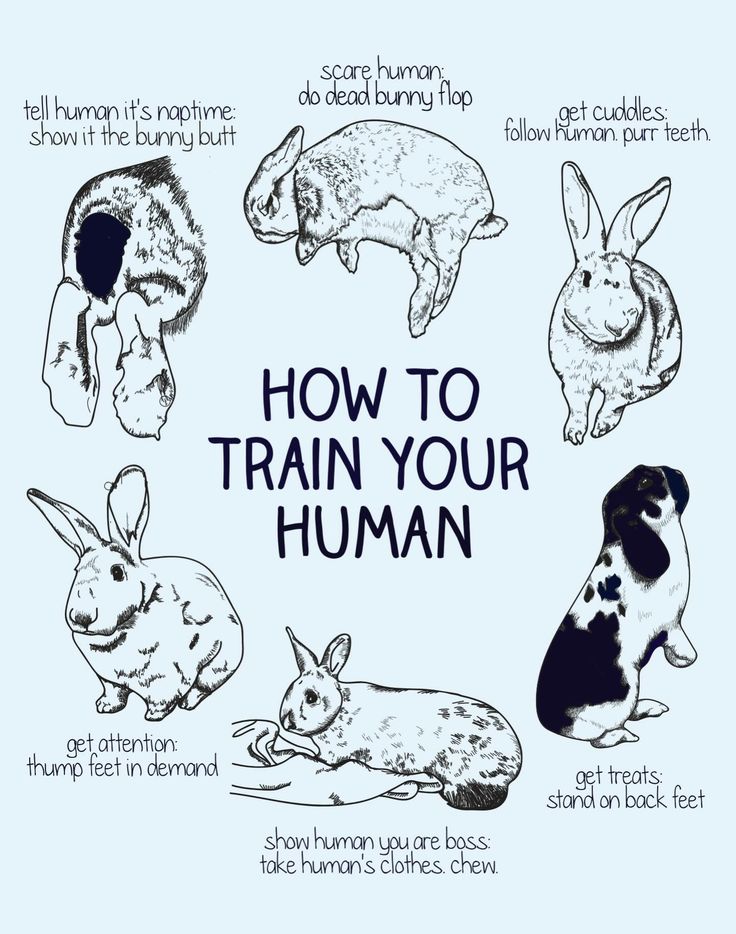 Wild cottontail and brush bunny rabbits should be released as soon as they are eating hay and greens and are approximately 5 inches in body length and run from you. This varies with the area, so size is not easy to say. They will be small, but the longer you keep them, the more agitated and difficult to handle they will become and the less likely their chances for survival in the wild. Release ONLY at dusk or dawn. Jackrabbits (hares) are not ready until 9+ weeks.Make sure they get exercise daily. Jackrabbits mature much slower than the brush/cottontails and need to develop strength. If they are ready, earlier, they will let you know.
Wild cottontail and brush bunny rabbits should be released as soon as they are eating hay and greens and are approximately 5 inches in body length and run from you. This varies with the area, so size is not easy to say. They will be small, but the longer you keep them, the more agitated and difficult to handle they will become and the less likely their chances for survival in the wild. Release ONLY at dusk or dawn. Jackrabbits (hares) are not ready until 9+ weeks.Make sure they get exercise daily. Jackrabbits mature much slower than the brush/cottontails and need to develop strength. If they are ready, earlier, they will let you know.
WARNING: Jackrabbits really NEED a skilled wildlife rehabber as they can run from you, throw themselves into walls to get away; many have died or severely injured themselves in captivity as they are so very wild. Please DO NOT raise them if you are not a skilled wildlife rehabber. This is vital. Noises and sounds easily frighten the jackrabbit and they are not able to be handled after 9 weeks. Often, sadly, we get reports of how a well-meaning person who tried to raise a wild rabbit, only to find it literally died of fright or got injured inside the cage. They are wild and belong with their own kind, out in the wild.
Often, sadly, we get reports of how a well-meaning person who tried to raise a wild rabbit, only to find it literally died of fright or got injured inside the cage. They are wild and belong with their own kind, out in the wild.
Jackrabbits really enjoy being raised together, whereas cottontails/brush bunnies may fight and do fine alone. Give them a carrier as their place of privacy (line with thick towels) with plenty of fresh hay and greens described above and water bowl. Again, wild rabbits need a skilled wildlife rehabber; it is critical to their survival.
The Bunny is DOMESTIC (i.e., pet rabbit, NOT wild) and Really Orphaned – How do I care for a domestic baby?
Baby Domestic Agouti Bunny Baby Domestic/Pet Agouti rabbit babyRemember that both the domestic pet rabbit and wild bunny moms only feed their young usually once in the middle of the night. Don’t assume the mom is not caring for them if you don’t see her nurse them. Check their tummies to see if they are round and the babies are warm in the morning–this means she is caring for them. In the rare situation that you have an orphaned domestic bunny, such as when a domestic rabbit mom is sick or refuses to care for her young, you will need to feed the babies. Overfeeding is a leading cause of death in these youngsters which results in fatal intestinal disease.
In the rare situation that you have an orphaned domestic bunny, such as when a domestic rabbit mom is sick or refuses to care for her young, you will need to feed the babies. Overfeeding is a leading cause of death in these youngsters which results in fatal intestinal disease.
If truly orphaned, use KMR KITTEN powder formula (can also use Meyenberg Regular Goat milk found at Safeway in the milk section or Whole Foods until you can find the KMR KITTEN formula), and follow the directions on the can. It may be easiest to start with a 3 cc/ml syringe or an eyedropper. Some use pet nurser nipples on the end of a luer lock syringe, or a teat cannula on the end of a syringe. Feed only with the bunny sitting UPRIGHT, and point syringe down towards bottom or side of mouth, so if too much comes out, the baby does not aspirate! For those who are slow to learn nursing, SC fluids may be necessary to prevent electrolyte imbalance or dehydration (check with a vet on this only!!). Domestic buns with closed eyes should be fed 2 x a day, and the number of feedings gradually decreased until they are weaned. If their eyes are still closed, you need to stimulate their bottoms with a warm moist towel after feedings to help them to pee. (Domestics are weaned about 6 weeks compared to wild bunnies who are weaned about 3-4 weeks for cottontails and 9+ weeks for jackrabbits). Bloat is commonly associated with too frequent feedings and too much at one time.
If their eyes are still closed, you need to stimulate their bottoms with a warm moist towel after feedings to help them to pee. (Domestics are weaned about 6 weeks compared to wild bunnies who are weaned about 3-4 weeks for cottontails and 9+ weeks for jackrabbits). Bloat is commonly associated with too frequent feedings and too much at one time.
Feeding Amounts for DOMESTIC/PET Orphaned babies*: Feed twice a day up to these amounts: Newborn– 2.5 cc/ml each feeding. One week old: 6-7 cc/ml each feeding. Two weeks old: 12-13 cc/ml each feeding. Three weeks to six weeks: Up to 15 cc/ml each feeding (a.m. and p.m.). Note this is for DOMESTIC, NOT WILD bunnies. Each bunny varies. If this is a smaller rabbit, he will consume much less. Do NOT overfeed! Contact an HRS contact, rabbit vet, to be sure.
*After each feeding it is important to make the bunny defecate and urinate (if the eyes are not opened yet) to keep the intestinal tract and urinary system running smoothly (only UNTIL their eyes are open). Use a cotton ball moistened with warm water and gently stroke the anal area until the bunny starts producing stool and urine and keep stroking until the bunny stops. You are reproducing the behavior of the mother rabbit who would lick her young to stimulate them to go to the bathroom and to keep the nest clean.
Use a cotton ball moistened with warm water and gently stroke the anal area until the bunny starts producing stool and urine and keep stroking until the bunny stops. You are reproducing the behavior of the mother rabbit who would lick her young to stimulate them to go to the bathroom and to keep the nest clean.
Provide a soft nest area in a box with clean towels, and cover the babies so it is dark until their eyes are open. Do NOT provide extra heat if the room temperature is at least 65 to 70 degrees F because excessive heat can be fatal. If the room is cooler, then you may place a heating pad on a low setting under no more than HALF of the nest so the bunny can move to a cooler area if it gets too warm, and be sure there is no way the mother rabbit can get to or chew the electrical cord!
For domestic rabbits, if you have a healthy adult rabbit at home and you can collect cecotropes (the soft, chain-like droppings that the rabbit usually eats) then these can be mixed with the KMR to give the baby bunny normal bacteria for its intestinal tract.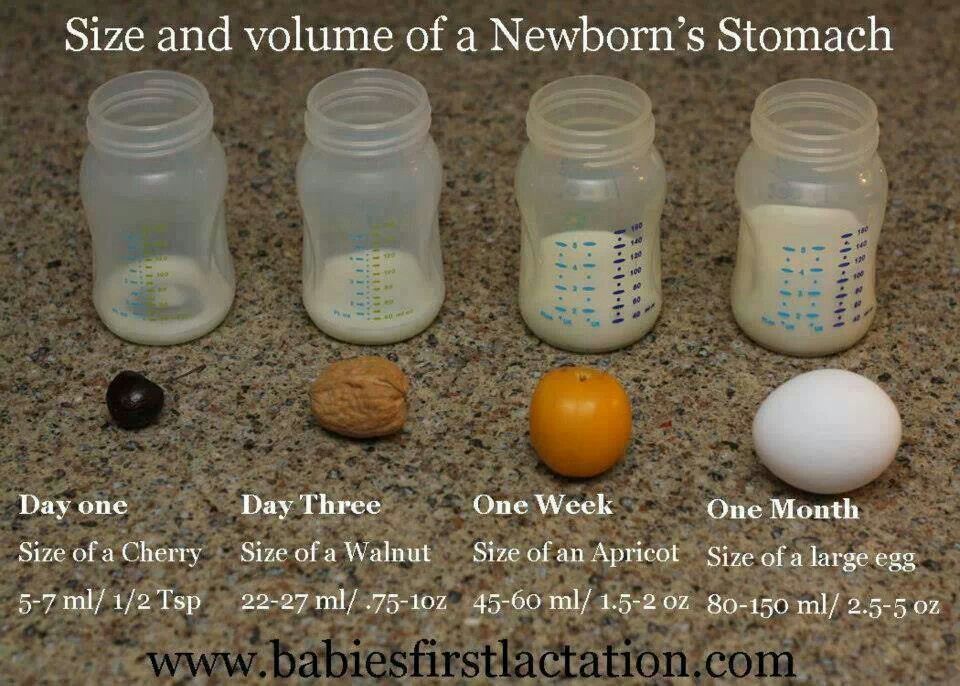 Only one cecotrope per day for 4-5 days is needed. This is particularly important for rabbits under one week of age. Also good is to sprinkle a pinch of acidophilus powder, also called “Probiotic” from human capsules in the milk a little each time for healthy flora for both wild and domestic bunnies.
Only one cecotrope per day for 4-5 days is needed. This is particularly important for rabbits under one week of age. Also good is to sprinkle a pinch of acidophilus powder, also called “Probiotic” from human capsules in the milk a little each time for healthy flora for both wild and domestic bunnies.
As soon as their eyes are open, you may introduce the bunnies to plain alfalfa pellets, hay, such as oat hay, timothy, alfalfa. Please refer to the handout Care of Rabbits for more information on diet for domestic, pet rabbits. You may reach [email protected] for domestic/pet rabbit questions. Below is the email for wild rabbit questions: [email protected] (wild) (If links above did not answer your question).
(See above for wild rabbits). For all rabbits, avoid ANY regular milk, puppy formulas, etc. Use KITTEN formulas like KMR. Avoid Esbilac. Feed only upright. Less is better than more! Overfeeding will cause bloat and pain and possible death. Please get to a rehabber.
Sources: Caring for Cricket – What Not To Do When You Find a Wild Baby Bunny by Julie Smith and Handout by Midwest Exotic Animal Hospital, and additional wild bunny info by M. Wilson (HRS educator and rehabber). For questions not answered about wild rabbits above, email: wildbunnyrehab at gmail.com
Below content was merged from: /caring-for-orphans/
Rabbit mothers nurse their babies for approximately 5 minutes a day. They will be in the nest or nest box early in the morning and then again in the evening. The milk is very rich and the babies “fill up” to capacity within minutes. Mother rabbits do not “sit” on the babies to keep them warm as do some mammals and birds. They build a nest with fur and grasses which helps to keep the babies warm in between feedings. Do not force a mother rabbit to sit in the nest box. You can pick up the babies and see if they are feeding by checking the size of their stomachs (should not be sunken in), the pinkness of their skin and activity level (they should not be blue in color or sluggish in movement) and the amount of time that you hear them crying (baby bunnies should be quiet most of the day…. if they are crying constantly then they are not getting fed). If they are warm, mom is most likely feeding them, but again, she only comes back in the middle of the night.
if they are crying constantly then they are not getting fed). If they are warm, mom is most likely feeding them, but again, she only comes back in the middle of the night.
If you come across a nest of bunnies in the wild and the mother is no where to be seen, please DO NOT disturb them…this is normal. By removing them from the nest you are greatly reducing their chances of survival.In the rare situation that you have an orphaned bunny, such as when a mother rabbit is killed by another animal or in the road, or when a domestic rabbit refuses to care for her young, you may try feeding with Kitten Milk Replacer (KMR) or Meyenberg Goat Milk (for wild rabbits, but they need a professional reahabber–do not feed at home). Remember though, that both wild/domestic bunny moms only feed in the middle of the night, so don’t assume she is not caring for them! For true orphans, remember to feed ONLY TWICE A DAY. Overfeeding is a leading cause of death in these youngsters which results in fatal intestinal disease.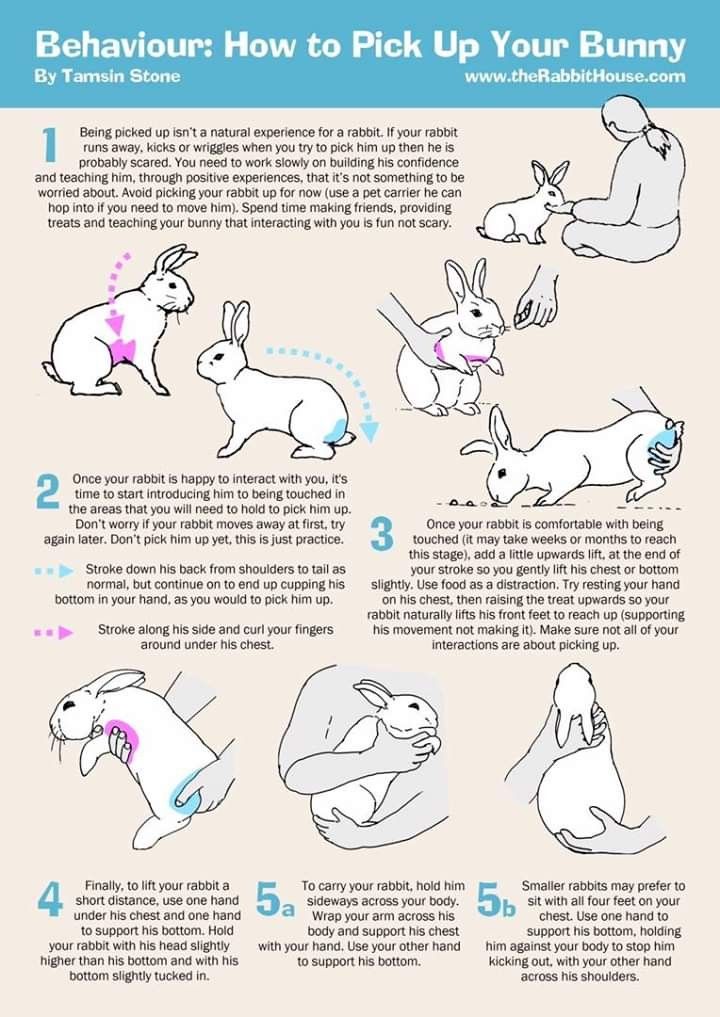 Provide a soft nest area in a box with clean towels, and cover the babies (if eyes are closed) so it is dark.
Provide a soft nest area in a box with clean towels, and cover the babies (if eyes are closed) so it is dark.
DO NOT provide extra heat if the room temperature is at least 65 to 70F because excessive heat can be fatal. If the room is much cooler, then you may place a heating pad on a low setting under no more than HALF of the nest so the bunny can move to a cooler area if it gets too warm.
For a wild bunny, you need to get him to a wildlife rehabilitator if he is TRULY orphaned (mom was killed). Remember with wild bunnies, the mom ONLY comes back at night to call and feed him; please put him back for her if just found and healthy. With domestics, the mom only feeds once or twice a day for only 5 minutes. Leave babies with the mom. For wild orphans, first google your state and wildlife rehabber, and call your humane society, also try http://www.humanesociety.org/animals/resources/tips/find-a-wildlife-rehabilitator.html and http://www.owra.org/find-a-wildlife-rehabilitatoror as it is illegal in most states to keep a wild animal, and they really need a professional as this is critical. Local rabbit veterinarians or humane societies may also know of a rehab facility.
Local rabbit veterinarians or humane societies may also know of a rehab facility.
The following is a guideline for the daily amount to feed a TRULY orphaned bunny (mother was killed, etc.) that will be about 5 lbs as an adult. It is impossible on the internet to be exact. Please find rehabber.
GENERAL FEEDING OF ORPHANS
Age + Amount (This WILL vary depending on type of rabbit.) Use KMR (Kitten Milk Replacer) for domestics and Meyenberg Goat Milk, regular not low fat for wild ones,or KMR. Add a pinch of acidophilus (AKA Probiotic capsules) to all formula to promote healthy gut flora. Other formulas vary depending on the region of the country. Avoid using Esbilac or any puppy formulas or cow’s milk. Do not add Karo syrup. FEED TWICE A DAY ONLY unless baby is low weight, than three times.
Newborn to One Week: 2 – 2+1/2 cc/ml each feeding (two feedings).
1-2 weeks: 5-7 cc/ml each feeding (two feedings).
(depending on bunny. .may be much LESS if smaller rabbit).
.may be much LESS if smaller rabbit).
2-3 weeks: 7-13 cc/ml each feeding (two feedings). Bunnies whose eyes are still CLOSED need to be stimulated to urinate and defecate before or after each feeding. Again, seek a professional on this. Domestic eyes open at about 10 days of age. Then start introducing them to timothy and oat hay, pellets and water (always add fresh greens for wild ones–dandelion greens, parsley, carrot tops, grated carrots, all fresh, watered down). See below for detail.
3-6 weeks: 13-15 cc/ml each feeding (two feedings–again, may be LESS depending on size of rabbit! A cottontail will take so much LESS–about half of this!.)
Domestics are weaned about 6 weeks. Cottontails wean and release about 3-4 weeks and jackrabbits much later (9+ weeks). Feed only twice a day up to these TOTAL amounts. You may find an eyedropper or syringe easiest to use. Feed them upright, and go slowly watching them lick and swallow so they do not aspirate. For domestic rabbits, if you have a healthy adult rabbit at home and you can collect cecotropes (the soft chain-like droppings that the rabbit usually eats) then these can be mixed with the KMR or goat milk to give the baby bunny normal bacteria for its intestinal tract. Only one cecotrope per day for 4-5 days is needed. This is particularly important for rabbits under one week of age. Acidophilus capsules for humans, opened and sprinkled some in formula, works well too.
For domestic rabbits, if you have a healthy adult rabbit at home and you can collect cecotropes (the soft chain-like droppings that the rabbit usually eats) then these can be mixed with the KMR or goat milk to give the baby bunny normal bacteria for its intestinal tract. Only one cecotrope per day for 4-5 days is needed. This is particularly important for rabbits under one week of age. Acidophilus capsules for humans, opened and sprinkled some in formula, works well too.
After each feeding it is important to make the bunny defecate and urinate (until their eyes are open) to keep the intestinal tract and urinary system running smoothly. Use a cotton ball moistened with warm water and gently stroke the anal area until the bunny starts producing stool and urine and keep stroking until the bunny stops. You are reproducing the behavior of the mother rabbit who would lick her young to stimulate them to go to the bathroom and to keep the nest clean. No need to do this for jackrabbits or if bunny’s eyes are open.
As soon as their eyes are open, you may introduce the bunnies to hay, such as oat and timothy hay, some alfalfa, and pellets, and for wild ones, add dark leafy veggies such as dandelion greens, carrot tops, parsley, grated carrots, etc. Keep the greens fresh, moist, and stand them up in a heavy mug of water. Change greens often. If this is a wild rabbit, you do not need to introduce pellets. If this is a domestic rabbit baby, then you may introduce plain alfalfa pellets at 2 weeks of age (please refer to the handout Care of Rabbits for more information on diet). Wild rabbits should be released as soon as they are eating hay and greens and are approximately 5 inches in body length (for cottontails) and are afraid of you (about 3-4 weeks). Jackrabbits are released much later (9 weeks up). They will be small, but the longer you keep them, the more agitated and difficult to handle they will become, and the less likely their chances for survival in the wild. They may be easily injured in your care as they attempt to get free.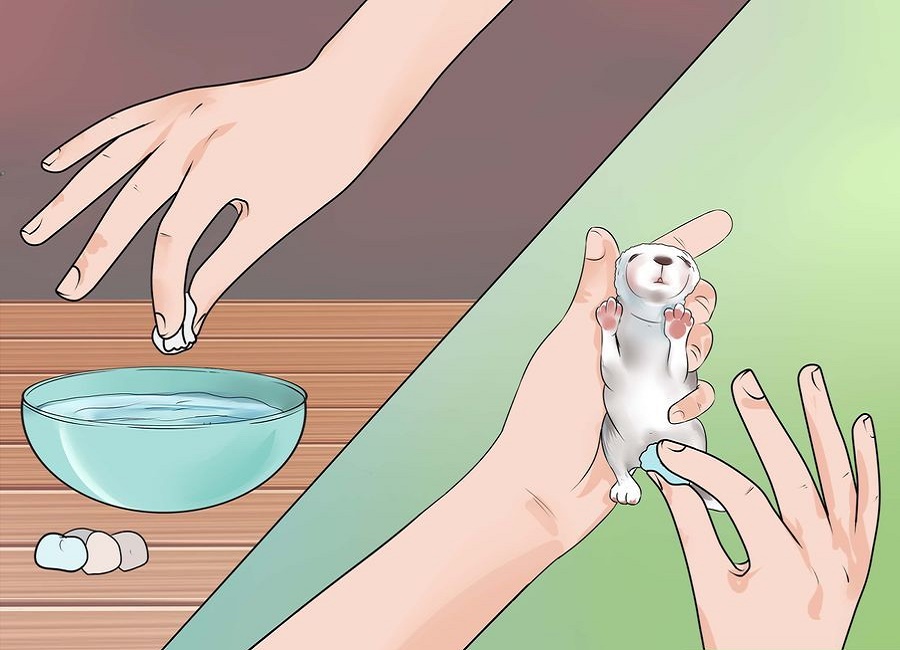 For wild bunnies, please do not raise them yourself, but take them to a rehabber! Google your state and wildlife rehabber or see links above.
For wild bunnies, please do not raise them yourself, but take them to a rehabber! Google your state and wildlife rehabber or see links above.
Modified from an original document from :
Midwest Bird & Exotic Animal Hospital
Artificial feeding of rabbits
– Hello. In the summer of 2014, all adult rabbits died overnight. They fought in convulsions, and blood came out of their mouths. There were small rabbits of different ages left. My husband and I tried to get them out: we fed them from a syringe and from a bottle with cow's milk. At first everything went well, but growing up, the rabbits began to die after feeding. They began to squeak, stretched out, as if they had convulsions. Sometimes after lying down a bit, they would leave. I began to dilute milk with water, maybe they had colic in their tummies? Of the 16 pieces, only 8 survived. All the rabbits of my acquaintances died, the symptoms are the same. I would like to know the cause of the death of the rabbits, as well as how to properly feed the babies if they were left without a mother?
E. A. Kuzmina, Rostov region Morozovsk
A. Kuzmina, Rostov region Morozovsk
Feeding rabbits is troublesome and in many cases almost hopeless. With artificial feeding, mortality is much higher than with a living mother. So there will be losses, and you immediately tune in to this and do not panic.
The main question in the artificial breeding of rabbits is what to feed? As experience shows, feeding with dry dog (bitch) or goat milk gives good results. In different sources, you can find options for mixtures for artificial feeding of rabbits. Here is a recipe for one of them: 1 part heavy cream (not less than 20%), 2 parts goat milk, 2 parts ready-made milk formula for kittens, bifidumbacterin for s / f on the tip of a knife and 1 drop of trivitamin per 2 ml of the finished mixture.
How to feed? Pet stores sell various kits for artificial feeding of fluffy offspring. But if you can't find them, don't despair. You can buy an ordinary small syringe without a needle in a regular pharmacy, or a pipette, or the cheapest eye drops in a small plastic vial. Drops should be poured out, the vial should be washed and then it can be used as a bottle for milk. Or you can take a simple baby bottle with a pacifier. Although the latter option is more suitable for already grown rabbits.
Drops should be poured out, the vial should be washed and then it can be used as a bottle for milk. Or you can take a simple baby bottle with a pacifier. Although the latter option is more suitable for already grown rabbits.
It is better to feed the baby rabbit in an upright position, holding him in your hands like a soldier and carefully pouring milk into his mouth in small portions. It is recommended to feed several times, as artificial nutrition is inferior in fat content and composition to mother's milk. But at least twice a day. A newborn rabbit needs about 5 ml of milk per day. So, with five meals a day, 1 ml per meal. A week after birth, the rabbits will already need twice as much milk, and at the age of two weeks, the rabbit should drink 15 ml per day. That is, already 3 ml per feeding with five meals a day. The dose of milk should not be increased at once, but gradually, adding a little every day.
There is one more nuance. Newborn rabbits cannot defecate on their own.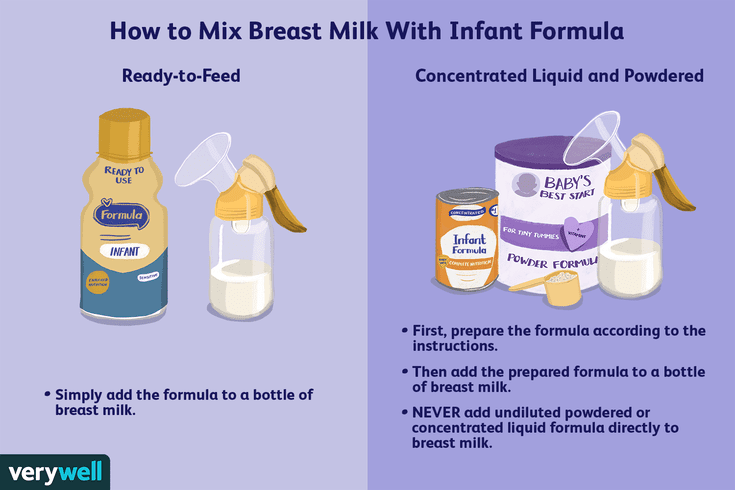 Under natural conditions, this process is stimulated by the mother rabbit; in the absence of a mother, you will have to take on this function. To do this, you will need a cotton pad or a napkin, which must be moistened with warm water and massage the rabbit's tummy in a certain way - from the navel to the hind legs. You don't need to go in the opposite direction. The rabbit should empty itself. Do this before every feeding. If the rabbit does not urinate before feeding, try again after feeding.
Under natural conditions, this process is stimulated by the mother rabbit; in the absence of a mother, you will have to take on this function. To do this, you will need a cotton pad or a napkin, which must be moistened with warm water and massage the rabbit's tummy in a certain way - from the navel to the hind legs. You don't need to go in the opposite direction. The rabbit should empty itself. Do this before every feeding. If the rabbit does not urinate before feeding, try again after feeding.
At the age of two weeks, grated carrots can already be given to rabbits. You can give fresh small grass or soft hay.
Be sure to put water in a shallow bowl, and bring the young rabbits to the drinker from time to time so that they learn to drink. By the age of one month, the rabbits are already able to eat all the "adult" food, and may well do without milk.
Daria RUDENKO
Feeding baby rabbits: features, techniques, tips
Mother feeding for the most part falls on the first three weeks of life of baby rabbits. Find out what to do if an unforeseen situation happens and the babies are left without a mother.
Find out what to do if an unforeseen situation happens and the babies are left without a mother.
From three to six weeks of age, baby rabbits need less milk and more pellets and hay. During the period when the rabbits no longer need mother's milk, they are weaned.
The physiologically reasonable weaning age is 3.5‒4 months and if you have a rabbit of this age at home, you can immediately give him roughage, additional milk feeding is used only if he suffers from malnutrition. At home, the rabbit is allowed to nurse her babies longer - up to the age of 6-7 weeks.
Loss of a nurse
Sometimes unforeseen situations happen - the death of a female or mastitis, aggressive behavior or refusal to feed the cubs. Whatever the reason, from now on, the care of the rabbits falls entirely on the shoulders of a person.
Further actions depend on the age of the rabbits and the presence of another female who can be assigned to feed them. Read this article to learn how to properly transfer babies to a foster mother.
Read this article to learn how to properly transfer babies to a foster mother.
If it is not possible to transfer the cubs to another female rabbit, they are artificially fed and some important points must be taken into account.
Sadly, the survival rate of motherless rabbits, if their eyes have not yet opened, and this is the age of 10-12 days, is very low. Mortality with inexperienced care can reach 80-90%. This means that out of ten rabbits, one or two survive.
There are many reasons for this catastrophic mortality rate, the main ones being:
Before rabbits begin to eat roughage, there are no bacterial populations in their intestines. If, during artificial feeding with milk formula, bacteria that are abnormal for rabbits of this age are introduced into the body, which can be caused by dirty hands or unsterilized nipples and bottles, this causes severe intoxication and indigestion. Diarrhea is one of the most common causes of death in rabbits.
If, during artificial feeding with milk formula, bacteria that are abnormal for rabbits of this age are introduced into the body, which can be caused by dirty hands or unsterilized nipples and bottles, this causes severe intoxication and indigestion. Diarrhea is one of the most common causes of death in rabbits.
Feeding supplies
Buy plastic teat bottles first. Since they are usually sold in pairs or as a set of a bottle and several nozzles, it is important to find the smallest nipples, and which bottle is not a big deal.
If you can get special teats for rabbits, great, if not, kittens will do. As one of the components, a milk replacer for kittens is introduced into the formula for feeding rabbits, and some manufacturers include a bottle with nipples in such a set, which is quite convenient.
Keep in mind that pet sellers often refer to rabbits as rodents or animals. So look for the products you need in one of these sections.
Special plastic syringes with silicone or rubber tips are successfully used.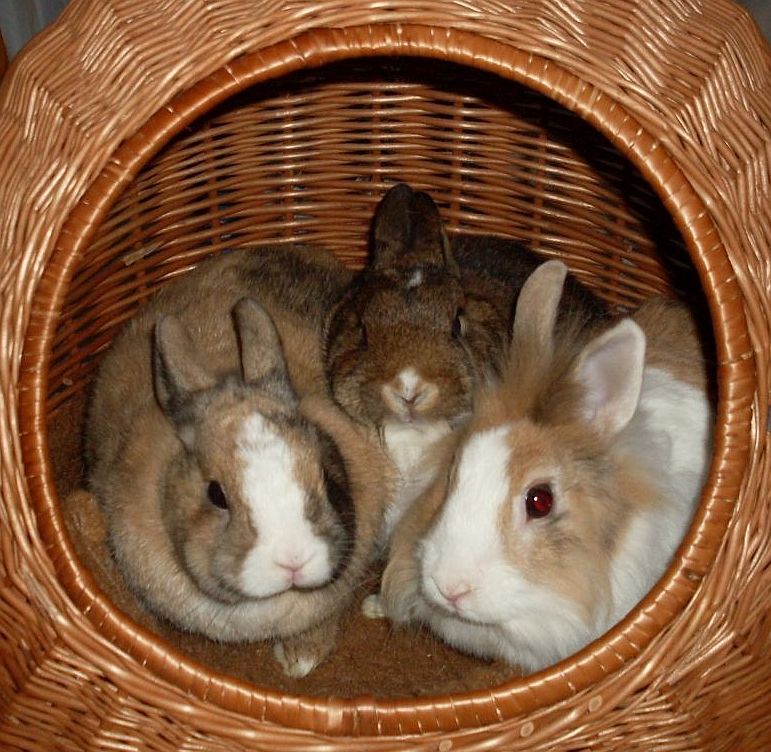
As an exception, try using a regular eyedropper or eye dropper bottle.
Successful rearing of young rabbits is not an easy task. Rabbits have a complex digestive system, and babies are even more vulnerable. Below is a universal formula formula for suckers of all ages.
For preparation take:
- fresh whole goat milk - 100 g
- Kitten milk replacer - 100 g
- colostrum (lyophilized colostrum) - 10-15 capsules (1-1.5 tablespoons)
Colostrum is an expensive ingredient, but it is almost impossible to raise very small rabbits without colostrum.
Place all components in a glass container, close tightly, then shake vigorously until the contents turn into a homogeneous mass.
Prepare a new formula before each feeding. If there are few cubs, you can reduce all components proportionally.
Heat the mixture to 40 °C, it is convenient to check the temperature with a regular thermometer, wipe it with alcohol before use. Keep cooked food in hot water until you have fed all the babies.
Keep cooked food in hot water until you have fed all the babies.
For older rabbits (from 14 days old), add up to 1 teaspoon of quality cow's milk cream to the mixture.
Condensed milk should not be used - excess sugars, prolonged heat treatment, vegetable fats and other components unusual for natural milk - all this will lead to the fact that the product can do more harm than good.
Cow's milk is inferior in nutritional properties and digestibility to goat's milk, moreover, it has less antibodies and larger fat globules, so it is undesirable to use it for feeding rabbits.
Feeding procedure
Remember, the most dangerous thing that can happen to young rabbits during feeding is inhalation of the mixture. This will lead to instant aspiration when the baby stops breathing and passes out, or to the rapid development of pneumonia. Therefore, when feeding, do not rush, do everything carefully, be leisurely, be patient and follow the steps below.
1.
 Cleanliness of dishes
Cleanliness of dishes Disinfect syringes, nipples and bottles in a special steam sterilizer or by boiling water.
2. Cleaning hands
Wash hands in hot running water with laundry soap (toilet soap is not used due to strong odor) and dry thoroughly.
3. Precautions
When feeding older rabbits, lie down on the floor - swift fidgets can jump out of your hands in no time. Place a towel on your knees. Wrap the bottle in flannel, the cub will rest on it with its front paws, as if it were fed by a rabbit, besides, the milk will not cool down.
4. Feeding
Hold the baby in one hand and the bottle in the other. Hold the baby horizontally with the tummy down, in the most natural feeding position, you can slightly lift the front or turn the baby to the side. Successfully feed rabbits in an upright position. No need to lay the sucker on his back - he can choke. It is enough to simply hold the grown-up rabbits with your hand, avoiding choppy movements.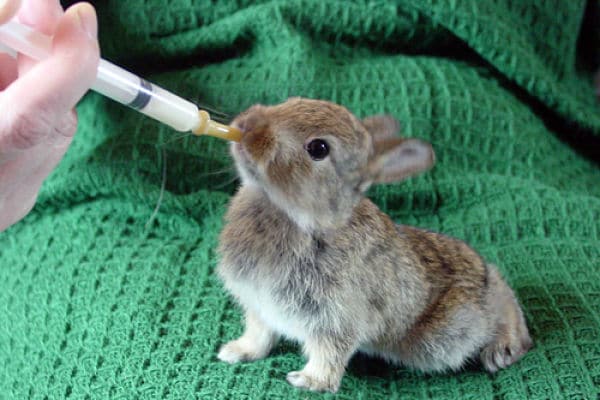
6. Patience
Rabbits, especially very small ones, often stubbornly refuse to suckle, some may take a day or two for the sucking reflex to develop.
It's not surprising that you might want to force-feed the little stubborn one. Don't do this under any circumstances! Be persistent, but be gentle and careful, squeeze out some of the mixture, moisten your mouth and continue to bring the pipette or nipple to it with a drop of milk, encouraging you to lick off the mixture.
Continue like this until the bunny begins to suck on its own. Sometimes it may take several feedings to be successful. If he grabs the nipple and starts sucking, let him eat at his own pace - no need to squeeze the bottle.
What should I do if my rabbit has inhaled the mixture and is not breathing?
If a baby rabbit inhales milk formula, the droplets can cause complete airway blockage and fainting. Therefore, you need to act very quickly and take urgent resuscitation measures.
Hold the baby rabbit in both hands, head up, with the palms of your hands firmly on the back and neck, but without squeezing too much. Raise it above your head and lower it down to the floor, moving not very fast, but with determination. Repeat the reception two or three times. The rabbit's insides will rush upward as they move down and push the diaphragm, which may be enough to push air and mixture particles out of the airways. As soon as the rabbit moves, stop immediately.
You will most likely need to administer antibiotics to prevent pneumonia, please consult your veterinarian about prescribing the drug.
Amount of portions, frequency and features of feeding
0–7 days
Newborn rabbits are fed twice a day, in the amount of 2–2.5 ml of milk mixture at each feeding.
Very small rabbits will not be able to recover on their own. The female rabbit, while caring for the sucklings, licks them, stimulating muscle contraction, which facilitates urination and defecation.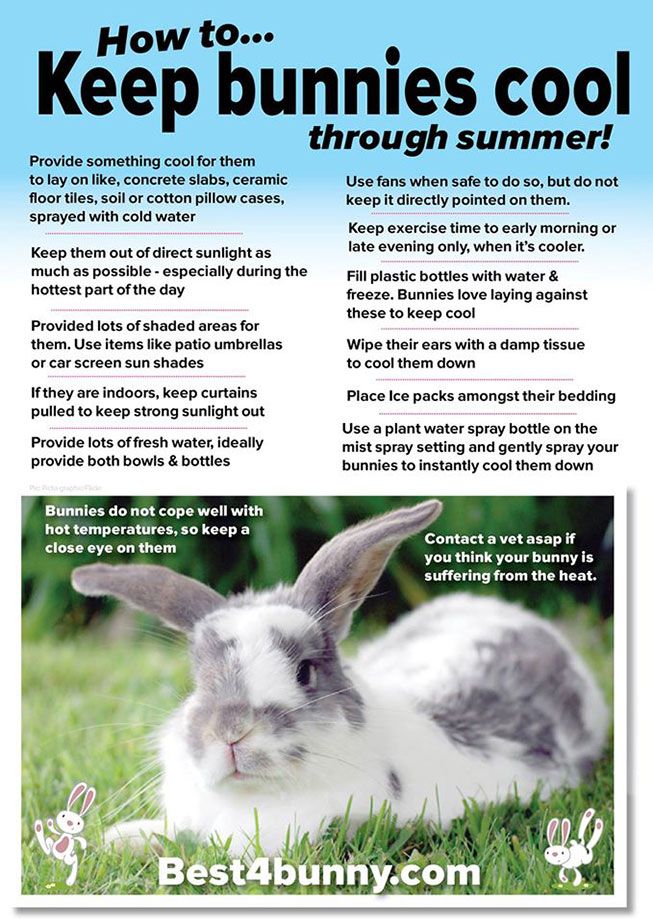
To prevent overfilling of the bladder and intestines, take the following action into service.
Rub the tummy, including the anus area, with light but firm strokes, as a female rabbit would do. Your task is to stimulate the tension of the abdominal muscles.
The procedure is performed with a finger moistened with warm water, you can wrap it with a damp cloth or use a moistened cotton swab. Manipulation will take from 15-25 seconds to two minutes and you need to continue it until the bladder is empty.
Some breeders find it best to do this before feeding and great if it works, but the extra pressure of a full belly can speed up and ease the process.
Be careful and persistent, sometimes rabbits cannot empty their intestines and bladder without light massage for quite a long time - up to a few weeks of age. Do not rub too hard as this can cause redness and irritation of delicate skin. If redness is still present, use a soothing calendula ointment.
8-14 days
The norm for this period is two feedings per day, 5-7 ml each time.
Don't overfeed your rabbit! Once he understands how the system works, he will eat as much as you give. He may eat so much formula that the tummy will stretch, causing discomfort, indigestion and gas.
It is better to underfeed a gluttonous baby than to overfeed. Well-fed rabbits look round and plump, but not like tumblers with stretched tummies.
In addition, it is important to take into account that the receptors that signal satiety do not work instantly and it takes some time. If the bunny looks hungry and you're not sure he's gotten enough food, wait a minute or two and offer the pacifier again, maybe he won't pounce with the same greed now.
15-21 days
Still two main feedings - 7-13 ml at a time.
By this time the eyes are already open and the rabbits begin to take an interest in what is happening around, including coarse food.
Timothy or oat hay, rabbit pellets and fresh water should now be constantly present in the cage. Rabbits are offered water not in an automatic drinker, but in a shallow bowl or bowl.
Rabbits are offered water not in an automatic drinker, but in a shallow bowl or bowl.
Experienced breeders recommend, even before the moment when the rabbits begin to consume roughage, to artificially introduce beneficial microflora into the body.
To do this, choose a donor - a healthy adult rabbit, not infected with helminths, and take some fresh caecotrophs from him (read about what it is here).
The resulting balls are kneaded, mixed with a small amount of milk mixture and fed to the rabbit, who, of course, will not be delighted with such food. Treat this event like giving medicine. This technique will make it possible to populate the rabbit's intestines with healthy microflora, and besides, caecotrophs contain many useful substances. Such an introduction of microflora for 2-3 days will be quite sufficient.
It is possible to replace caecotrophs with probiotics, such as the German Olin or the domestic Zoonorm.
22-42 days
Two feedings of 13-15 ml at a time, the amount of servings may be smaller, depending on the breed and development of the rabbit.
At this time, alfalfa or clover hay is introduced into the diet, as well as granules with a high protein content - 16-18%. You can additionally introduce some sunflower seeds or whole oat grains.
Weaning
A female rabbit feeds her young at home for up to eight weeks or more, gradually reducing the frequency of feedings until the young rabbits lose interest. As early as two weeks, rabbits will begin to gnaw on pelleted food and taste hay, but this is not a reason to stop feeding them a mixture. On the contrary, during this period, in no case should you stop the main feeding.
Colostrum containing useful antibodies will help the rabbits to control the development of microflora, and restrain the growth of potentially dangerous colonies.
From 6 to 8 weeks of age, start diluting formula with clean drinking water. Start by adding a quarter of water, gradually bringing the composition to this proportion: three quarters of water - one part of the mixture.



